Home > Highlighting JAPAN > Highlighting Japan AUGUST 2012 > FUTURE TRANSPORT—Greener Ways to Get Around
Highlighting JAPAN
COVER STORY: FUTURE TRANSPORT—Greener Ways to Get Around
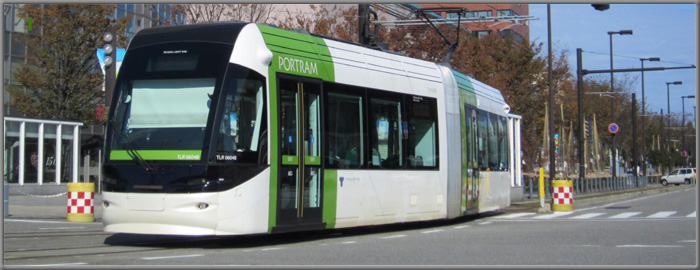
An LRT train in Toyama City, Toyama Prefecture. Toyama City is located half way up the Sea of Japan coast of the main Japanese island of Honshu, flanked by mountains which form part of the Northern Japan Alps. Surrounded by natural beauty and marine bounty, Toyama City, home to 420,000 people, was last year selected as a FutureCity.
Credit: COURTESY OF TOYAMA CITY
FUTURE TRANSPORT—Greener Ways to Get Around
At the United Nations Conference on Sustainable Development (Rio+20) held in Rio de Janeiro, Brazil from June 20 to June 22, the Japanese government declared that it would implement its Green Future initiative. One of the pillars of that initiative is to spread successful examples of the "FutureCity" Initiative worldwide. The Future City Initiative selects several cities and regions as environmental future model cities that have produced solutions to problems common to all humanity, such as environmental issues and an aging society, and then introduces those solutions throughout Japan and overseas with the aim of expanding demand and creating employment.
The "FutureCity" Initiative includes, as a major theme, the dissemination of means of transportation that have a low impact on the environment and on an aging society. The various cities selected to be FutureCity this year have specific action plans for the use of electric vehicles, for ultra-small mobility and car sharing.
We asked Haruo Ishida, professor at the University of Tsukuba and one of the people who select Future Cities, about some of the unique features of transport systems in Japan.
"Because urban development has been centered on railroads for the last 100 years, major Japanese cities have highly developed railroad networks. Using Tokyo as an example, rail lines radiate out from the Yamanote Line (see here), which is the central loop line, and town areas have developed along these lines. More than 90% of the workers who commute into the city center use the railroad," Professor Ishida said.
In the case where people travel the same distance, rather than use automobiles, which can hold only a small number of passengers, the use of public transportation such as railroads and buses, which can move a lot of people, has a smaller volume of carbon dioxide (CO2) emissions per person. People whose living sphere is the city center live along the rail lines and shop in neighborhoods around the train stations. As a result, the urban structure consumes little energy to transport people. "Japan's major cities Tokyo, Osaka and Nagoya can be said to be unmatched in the world when it comes to cities that have a low impact on the environment," Professor Ishida said.
On the other hand, for people living outside of the cities the automobile is indispensable. Japan's motorization has developed to the point that it is not unusual to find families that have two or more cars.
"Recently, the volume of CO2 emissions and the 'mobility divide' have worsened. The 'mobility divide' is the sum of the differences in lifestyle between those people who have automobiles and those people who don't. People who don't own automobiles, particularly the elderly, have a lifestyle that makes it extremely inconvenient to go shopping or to go to the hospital. This is not just true for Japan; it is a global problem. The dissemination of transportation that has a low impact on the environment not only reduces CO2 emissions; we hope that cities will become places where even the elderly are able to actively participate in society," Professor Ishida added.
"FutureCity" play an important role as models of urban development for the rest of the world. This month's feature article, above all, introduces the next generation of transportation systems being used in Japan and disseminated overseas.
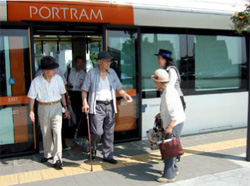
Elderly residents of Toyama City travel more often since the introduction of the Light Rail Transit service. Toyoma is also developing a community bus service and promoting the widespread use of shared bicycles.
Credit: COURTESY OF TOYAMA CITY
Toyama had earlier decentralized its residential areas through the development of its suburbs and had an excessive dependency on automobiles. These increased burdens on the environment and elderly residents. In addition, the decentralized residential areas meant rising administrative costs such as those for road and sewer system maintenance.
As a result, the city decided to aim to become an efficient and sustainable compact city by stimulating the use of public transportation and concentrating the functions of a city, such as residences and commercial facilities, along rail lines and it was decided to link this plan together by introducing an LRT.
Following the start of operations, Toyama Light Rail has seen its ridership increase by 2.1 times on weekdays and by 3.6 times on weekends and holidays. Use by the elderly during the daytime has also increased. Toyama Light Rail has increased the frequency of LRT runs and LRT is a barrier-free train. In addition, about 12% of LRT riders have converted from automobile to LRT travel, which has reduced CO2 emissions in areas along the rail lines by 436 tons annually.
In recognition of this policy, in June of this year, Toyama City was introduced on a par with Melbourne, Australia and Vancouver, Canada as one of the five advanced compact cities in a report by the OECD (Organization for Economic Co-operation and Development), Compact City Policies: A Comparative Assessment.
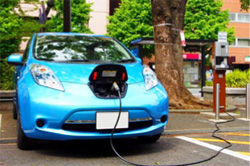
An electric vehicle charging station in Yokohama. There are about 250 charging stations in the city, located at ward offices, department stores, convenience stores and car dealerships, among others.
Credit: TADASHI AIZAWA
Moreover, in cooperation with Nissan in the Yamate and Motomachi areas where commercial buildings, schools and tourist attractions are concentrated, two-person ultra-compact electric vehicles were given performance tests in October and November of last year, each for a period of about two weeks. This was the first time that two-person ultra-compact electric vehicles had been operated on public streets in Japan. Local residents and tourists who tested the vehicles were heard to comment, "It is good in tight turns, easy to drive," and "There is plenty of horsepower to get up hills without any problem."
The city of Yokohama and Nissan have a goal of being "the easiest city in the world to drive an electric vehicle" as it aims toward realizing a sustained mobility society.
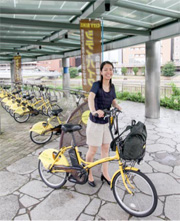
City Bike parking area at Kitakyushu City Hall. The roof is fitted with solar panels. City Bike users include shoppers, company employees, tourists and local government workers. According to surveys of City Bike users, about 30% answered that they had switched from their personal cars to using City Bike. A "One-day passport" is 500 yen.
Credit: YUICHI ITABASHI
In 2010 Kitakyushu started a system of shared use electric motor assisted bicycles called "City Bike." At ten special City Bike bicycle parking areas, anyone who registers as member and pays "One-day passport" can use an electric motor assisted bicycle. Currently, there are 116 units at special "City Bike" bicycle parking areas in use and these can be rented or returned anytime and to any "City Bike" parking areas, 24 hours a day. The bicycle parking areas have solar panels which are used for lighting and to charge the bicycles. There are bicycle sharing systems around the world but Kitakyushu is said to be the only one that has only electric motor assisted bicycles.
The reason that Kitakyushu introduced electric motor assisted bicycles is because it is a town with a lot of hills. With an electric motor assisted bicycle, even the elderly are able to easily climb hills just by motor assisted pedaling.
There have been more than a few visitors from overseas as a result. In May of this year, the deputy mayor of Stockholm, Sweden visited Kitakyushu and expressed interest in introducing City Bike to Stockholm.
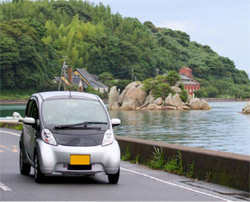
An electric vehicle on the coast of Fukuejima in the Goto Islands. In May of this year, the International Energy Agency (IEA) introduced sixteen cities and regions with the best practice EV policies in the world in its EV City Casebook and the Goto Islands were ranked alongside major cities including New York and Berlin.
Credit: YUICHI ITABASHI
The Goto Islands are aiming for the implementation of Future Drive Tourism, and the administration is now carrying out the Nagasaki EV & ITS Project, which makes use of electric vehicles (EV) and an intelligent transportation system (ITS). Currently, there are about 140 EVs in the Goto Islands, of which more than 80% are rental vehicles. There were more than 6,700 EV rentals last fiscal year alone. The largest island in the Goto chain, Fukuejima, is about 100 kilometers in circumference so it is possible to just about make it around the island on a single charge.
"During the summer vacation period, there is so much interest that there are not enough EVs," said Yoko Hashimoto, president of car hire firm Rent-a-Car Tsubaki. "It's good for the environment, easy to drive… EVs have a good reputation. We have a lot of repeat customers."
In addition, the ITS Spot, which will begin full operations in October of this year, will automatically display on EV monitors not only maps and tourist information but also natural disaster and flight information.
Toyota Ecoful Town
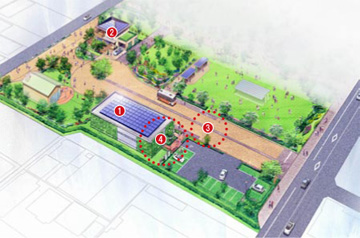
❶Pavilion
(see photo right)
❷Smart House
In addition to preventing sunlight from shining inside, smart house designers have ensured good indoor ventilation.
❸ITS
Here visitors can experience new technologies such as demand-responsive transport systems and pedestrian detectors.
❹Energy Management System
On display here are facilities such as storage batteries and charging stations.
By 2014, more facilities will be added, including a new smart house, a hydrogen station to produce and supply fuel for fuel cell vehicles, and a restaurant where guests can enjoy dishes prepared with locally grown foods.
In the Pavilion at Ecoful Town, visitors can learn through videos and quizzes about Toyota City's efforts in the field of environmental technology, and in a "model home" equipped with a cutting-edge solar power generation system, storage batteries and home energy management system (HEMS), visitors can discover firsthand the attractions of smart houses. At two locations in the city, sixty-seven such smart houses have been sold, and some people are already living in the homes as part of ongoing demonstration experiments.
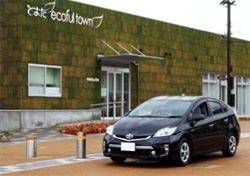
The Pavilion at Toyota Ecoful Town is equipped with solar panels on its roof and a kind of moss covering its walls to keep indoor temperatures from rising. Meanwhile the roads within the grounds are paved with materials high in water retention and thermal insulation properties, which helps prevent ground surface temperatures from rising.
Credit: TADASHI AIZAWA
Ecoful Town has already been visited by large numbers of the general public, as well as by foreign government officials and representatives of the national and local governments in Japan, business firms and universities. Visitors have shown particular interest in ITS and the model smart house, with many asking how they can go about actually purchasing such a home for themselves.
"Ecoful Town allows us to show visitors from home and abroad how Toyota City is striving to create a low-carbon society," says Mayor Toshihiko Ota. "We hope we can help popularize this enjoyable, pressure- and waste-free way of life, one that harnesses the latest environmental technologies, in countries around the world."
© 2009 Cabinet Office, Government of Japan






